On Thursday, August 16, 2013 I had the honor of delivering the keynote address for the 2013 Organization of Canadian Symphony Musicians (OCSM) Conference and I wanted to share the slides and a transcription of the speech with Adaptistration’s readers.
 But first, a few provisos for context:
But first, a few provisos for context:
- This is a transcription of a live speech so thank you in advance for realizing that the copy is designed for spoken word, not written text.
- Portions of the address rely on planned improvisation and interaction with the delegates. Perhaps unsurprisingly, that content is not included in this version.
- There are a number of references to individuals, events, and related situations in the address where the presentation context (specifically, an orchestra musician conference) provided a common knowledgebase that removed the need to provide related descriptions. Consequently, you may fail to make those connections if you do not possess the same frame of reference.
- You can click any of the slide images to enlarge.
The Q&A session at the end was fascinating as a number of delegates presented some very thoughtful questions and observations. Those aren’t something that can be shared here but I’m happy to answer questions from readers via comments so feel free to send something in.
Hi, I’m Drew McManus and I love what I do. There’s nothing better than sitting around with musicians, managers, board members and patrons talking shop. A day filled with analyzing income/expense reports, revising governance bylaws, and exterminating bad orchestra websites one group at a time can only get better if there’s dinner that evening with colleagues to talk shop. And gin.
That’s all a roundabout way to say that I’m a geek. What other reason would there be for taking conference time usually set aside for inspirational sunshine, smiles, and rainbows to talk to you today about “a sociological analysis of the orchestra field and how this can benefit you as an orchestra musician and union representative.”
The frank answer is passion; passion for discovering something that when you hear it for the first time is so light bulb obvious that you wonder why you haven’t heard it before, and a passion for making things better simply because we can.
So, let’s get passionate about Fourth Generation Theory.
Fourth Generation Theory is an analytical tool used to identify patterns in historical generations that ultimately lead to cyclical rotations; in English, it provides a basis for identifying how long it takes before history begins repeating itself.
Keep in mind, it is not intended to be a precise science; instead, it is a tool best used to identify cyclical patterns, variances in those patterns, and what individuals and institutions can do to help better navigate the related events.
I started to apply Fourth Generation analysis to the orchestra field at the turn of the century and that work began to produce meaningful results by 2004 once the fourfold cycle was recognized. The next trick was to identify the related generational archetypes. But I’m getting ahead of myself.
To that end, let’s define what a generation is within the context of the professional orchestral musician.
[/tab] [tab title=”GENERATION DEFINED”]
- Each generational pattern progresses in fourfold cycles with each stage lasting approximately 20 years. A typical orchestra musician career will last ¾ of that cycle.
- Individuals within the cycle tend to gravitate to a mindset based on shared traits shaped by common experiences during the formative academic and early career years. To this end, individuals tend to share similar workplace attitudes toward relations, risk, customs, and values.
- Generational groups, or archetypes, are flexible and their collective response to key events will change as they move through age ranges. What this means is each archetype influences outcomes, even if similar key events are encountered at different career points in the fourfold cycle.
It is crucial to understand that archetypes influence models, not the other way around. Granted, new models are all the rage in the orchestra field but in the end, they are only as worthwhile as the people involved so understanding how, and perhaps more importantly, when generational archetypes intersect key events will help influence positive outcomes.
[/tab] [tab title=”GENERATIONAL ARCHETYPES”]
There are currently five generational archetypes moving through the fourfold orchestral cycle, with the final group expected to begin entering the workforce around 2020. It’s important to keep in mind that the chronological grouping for each generational archetype is flexible and individuals at either end tend to share traits with the adjoining group.
- Silent Generation: started their career from 1940-1960.
- Baby Boomer: entered career from 1960-1980.
- Gen X: entered career from 1980-2000
- Millennials: began entering the workforce in 2000.
- Plurals (AKA Gen Z or the Homeland Generation): are just entering music schools and will begin entering the workforce in approximately 2020.
And although dominant traits associated with each generation can be cyclical, it’s important to note that these cycles do not coincide with historical cycles. Meaning, don’t expect the Plurals to be modernized carbon copies of the Silent Generation.
Let’s put this new understanding to good use and take a look at the cycle as applied to the orchestra field and where these generational archetypes fit into that framework.
[/tab] [tab title=”THE FOUR GENERATIONAL CYCLES”]
History’s fourfold cycles can be broken down into the following stages:
- Crisis: this period is defined by a key event that ushers in fundamental strategic change; when they run hot enough, they produce what’s known as a Founding Moment which is a type of key event capable of redefining the field’s fundamental identity. Traditional institutions are challenged, and individuals begin to gravitate toward a larger, collective identity. Risk aversion is very low and confidence, optimism, and collective outlook are very high.
- Development periods are marked by a sharp rise in institutional strength from collective efforts which refine a strong sense of identity that inspires building, or rebuilding, infrastructure. Risk aversion is low while demand for order and institutional trust are high. Likewise, participation rates among multiple generation groups are at comparative highs.
- Stabilization periods are characterized by a dichotomy of traits that shift over the course of the period. Early and mid stages are characterized by record setting growth and reduced conflict. Latter stages are characterized as an “enjoying the fruits of our labor” period where infrastructure maintenance is sharply decreased. Risk aversion spikes throughout the course of the period as do idealism and self-expression outside collective institutions.
- Unraveling periods are the most perilous as they typically determine whether the subsequent Crisis period produces Founding Moment level change. The onset of this time is characterized by a strong sense of laissez faire individualism and the increasing erosion of infrastructure produces a fundamental gap in institutional knowledge of events from preceding periods. The generation populating the bulk of this period has a strong sense that the way things are is the way they have always been. Risk aversion and cynicism are very high while collective identity is at historic lows. Institutions become increasingly distrusted and traditional leaders become entrenched and reactive.
The next step in the process will overlay key events in the orchestral field with this fourfold cycle.
[/tab] [tab title=”ORCHESTRA GENERATIONAL CYCLE”]
The orchestra field’s crisis period and related Founding Moment took place in the early 1960s when orchestra musicians reached a catalyst for action:
- First, they determined their employers were not maximizing community potential capable of supporting improvements in artistic excellence, workplace satisfaction, and standard of living.
- Second, they subsequently determined that the only way to bring about this change was to firmly establish a previously unseen level of self determination and control over the collective bargaining process. Simply put, they started bargaining directly on their own behalf via elected representatives for wages, benefits, working conditions, and protections against debilitating workplace abuses.
These movements ultimately led to the birth of the player conferences, the first of which was ICSOM. Orchestra musicians in cities such as Chicago absorbed a tremendous amount of personal risk for the benefit of the collective whole and as history has shown, those sacrifices and collective action have produced dynamic positive outcomes.
The transition period from Crisis to Development was marked by the inclusion of ICSOM into the AFM as an official conference and the establishment of what is now known as the Symphonic Services Department.
The remaining cycle witnessed steady growth among North American orchestras; budgets increased as did standards of living. Moreover, a unified collective identity between player conferences and the AFM began to emerge (after an admittedly rocky start). This cycle also gave birth to two new orchestral player conferences; OCSM was founded mid cycle to serve the needs of Canadian orchestral musicians and by the end, ROPA was formed to focus on the needs of a new class of emerging regional orchestras.
The transition between Development and Stabilization cycles was marked by the creation of an institutional infrastructure that included detailed training and reference materials, a strong peer support system, a refined and expanded national resource center, and a communication network that maximized technological offerings of the day. Cooperation, communication, and collective identity reached previously unseen levels.
Although certainly not free of conflict, the Stabilization period leveraged labor disputes to usher in the notion that not only could orchestra musicians earn a living wage, they could earn a wage commiserate with their skill set and training from a single employer. The quantity of 52 week orchestras expanded and the threshold became a new benchmark for status and success. Work rules improved to reduce job related injuries and protection from Crisis cycle style exploitation from music directors and administrators willing to abuse his or her position for reasons counterintuitive to institutional good.
Toward the end of the cycle, participation in collective identity began to decline while training and support infrastructure became increasingly outdated. Orchestra musicians were slow to adopt new communication technologies, cross-generational peer support waned and by the end of the cycle, the new standards of living pushed risk aversion to all time highs.
This is where things get really interesting and before we look at the Unraveling cycle, let’s overlay this chart with the Generational Archetypes.
[/tab] [tab title=”GENERATIONAL OVERLAY”]
Improvise. Key points:
- Point out the gap between the first and fourth generations.
- Lost in this gap is the notion that cooperation and building/maintaining infrastructure produce collective prosperity.
- The increased culture of individualism and self enjoyment among the Gen X will be central to deciding how to move forward with strategic planning and goals.
Now, if this isn’t exciting enough, let’s ratchet things up a bit. Remember the onset of the keynote where I mentioned that cyclical patterns are flexible? Well, as it turns out this fourfold cycle is a bit distorted in that the next big Crisis cycle is about 10 years ahead of schedule.
[/tab] [tab title=”DISTORTED CYCLE”]
Improvise. Key Points:
Negatives
- Economic downturn impacted not only employers but musicians as many Boomer and Gen X individuals adopted equally untenable financial practices.
- Political Polarization: sharply divided value camps gain dominant control of strategic decision making among employers and employees.
Positives
- Unique occurrence in that the early crisis occurs at the narrow window of opportunity where three generations of musicians simultaneously occupy meaningful ratios of the workforce. This holds the potential for larger than normal numbers of Boomer, Gen X, and incoming Millennials to draw from the largest possible skill sets to plan, implement, and benefit from a resurgence of values and traits generally found during Development and Stabilization cycles.
-
Leverage weakness as strengths:
- Although training and support infrastructures lag behind where they could or should be, this brings the opportunity to make substantial improvements in comparatively shorter time frame than generations past. The result is a substantially higher return on investment that unfolds in real time.
- Reactionary advances from employers can help reignite lost sense of collective community; however, leveraging that into actionable results will require serious work to counteract high levels of risk aversion. Simply put, outrage does not guarantee action.
Typically, a Crisis cycle begins with a catalyst that triggers a sudden shift in collective mood. Move ahead several years and the respective generation members usually begin to draw together with a stronger sense of community as a way to combat the challenges.
This is the point where history begins to repeat itself.
But here’s the Mahler 6 hammer blow with regard to the current premature Crisis cycle; the outcome of musicians’ efforts determine whether or not it will produce a Founding Moment style transitional event. For orchestral musicians this can end one of a few ways and yes, most of them of aren’t very good. At the same time, it is undeniable that the eventual outcome is still very much within the realm of influence here and now.
In order to marginalize the crisis and prevent a negative Founding Moment event, existing institutions will need to set aside polarizing influences, modify conventional beliefs that no longer serve a practical purpose, share authority, and accept increased sacrifice (beyond financial wellbeing).
[/tab] [tab title=”LOOKING TO THE FUTURE”]
None of this will transpire easily or without what might seem like great expense; but in the end, it will never be more affordable than right now as the cost in time, treasure, and talent only increase as the Crisis cycle develops.
To this end, I’m looking forward to working with delegates and esteemed guests throughout the remaining conference to help with the initial steps in that process.
At this time, I want to thank everyone for following along on this geek-stavaganza journey of analysis and I’d like to open up the floor to discussion and questions regarding these points along with any related items.
[/tab] [tab title=”THANK YOU”]
[/tab]
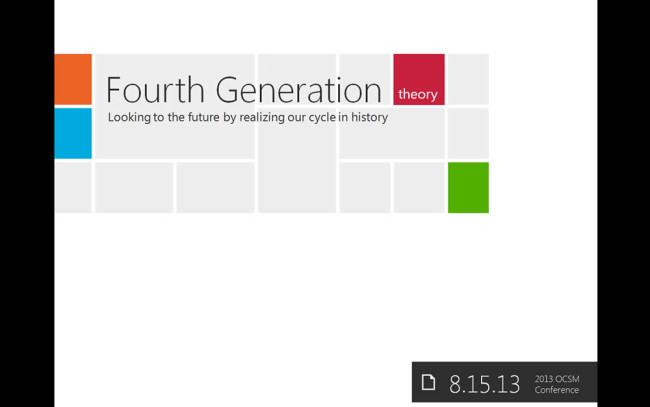
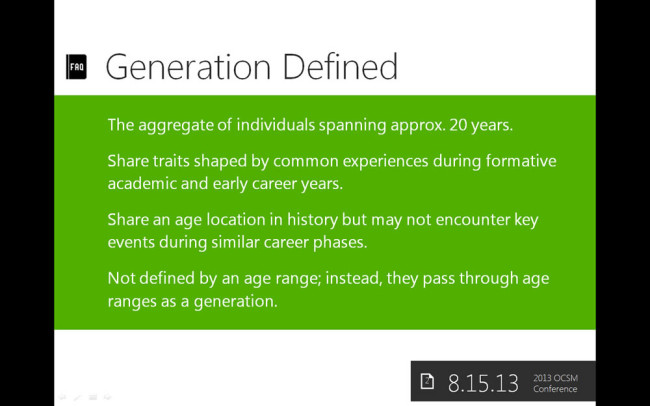
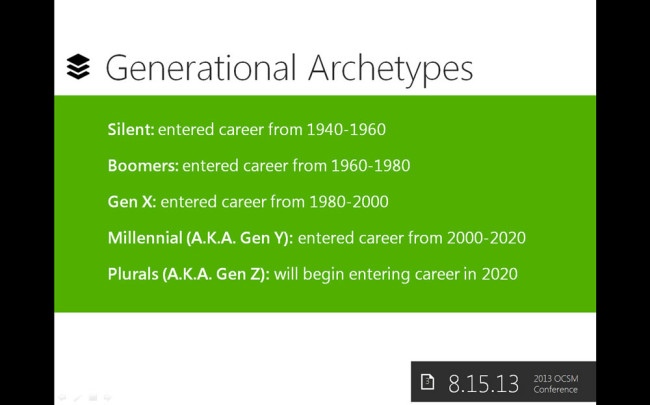

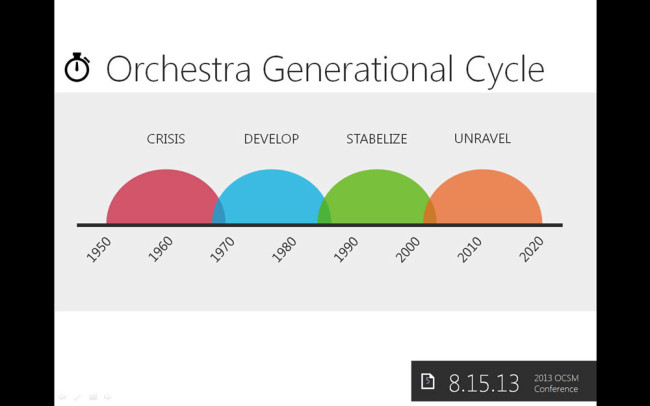
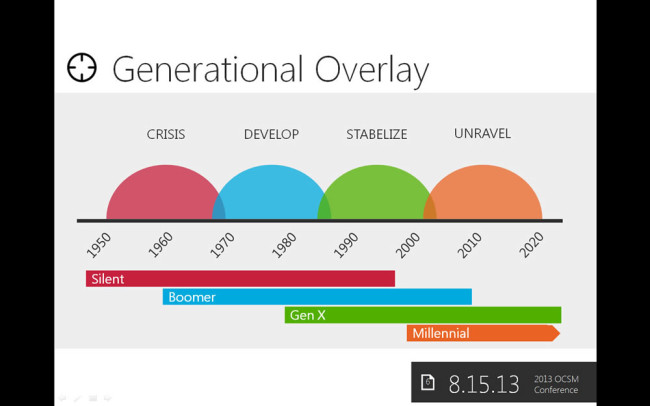
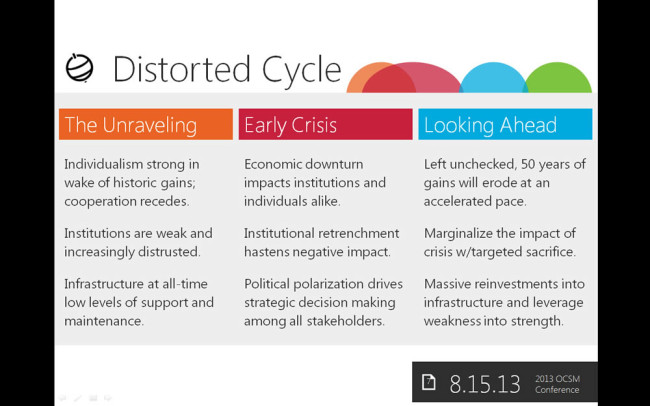





1 thought on “OCSM Keynote Address: Fourth Generation Theory”